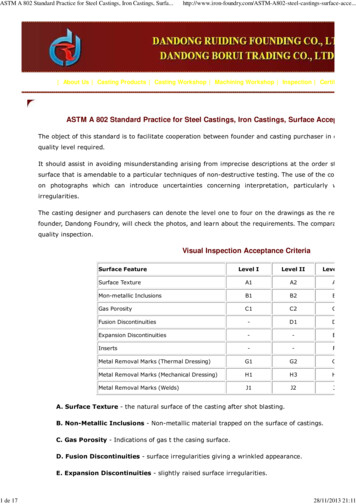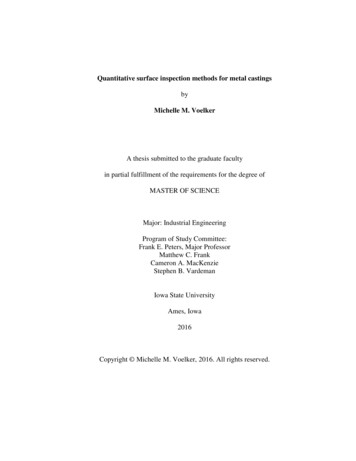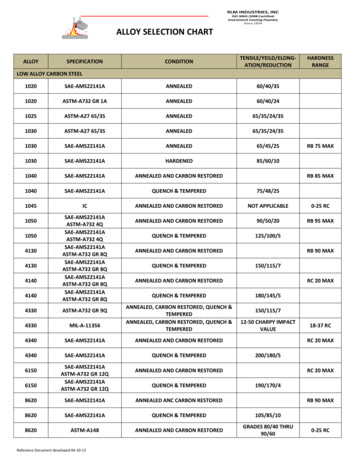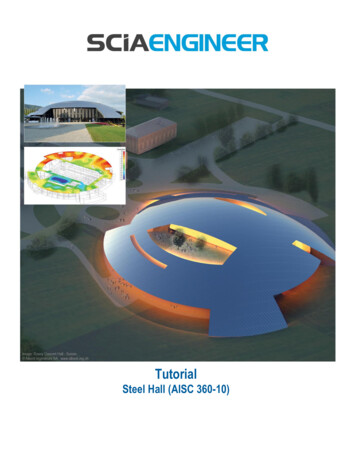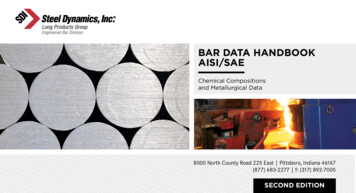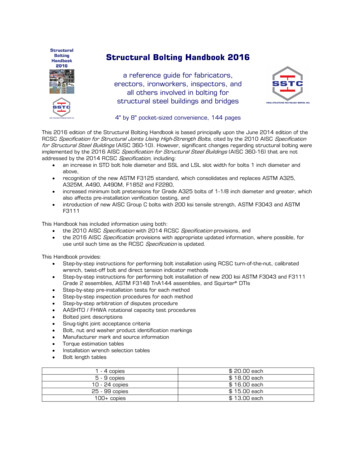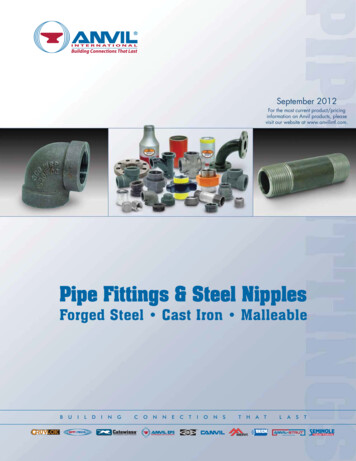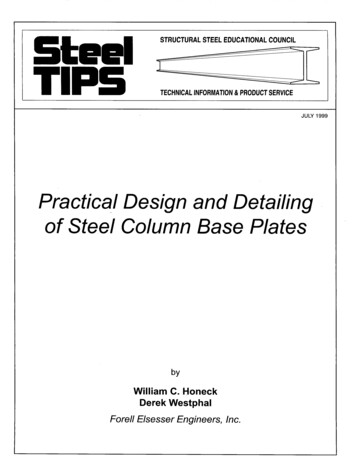
Transcription
STEELCASTINGSHANDBOOKSUPPLEMENT 22017SUMMARY OF STANDARDSPECIFICATIONS FORSTEEL CASTINGS
Steel Castings HandbookSupplement 2Summary of Standard SpecificationsFor Steel Castings - 2017PREFACESupplement 2 will be revised at regular intervals. Supplement 2 is only a summary that is useful in comparing thegeneral requirements in different types of specifications. When ordering, an up-to-date original specificationshould be used.CONTENTSORDERING STEEL CASTINGS. 3OVERVIEW . 3DESIGN . 3Background. 3Minimum Section Thickness . 3Draft. 3Parting Line. 4Cores . 4Internal Soundness/Directional Solidification . 4Machining . 4Layout . 5MATERIAL . 5TESTS . 6SUMMARY OF MATERIAL SPECIFICATIONS FOR CARBON AND ALLOY CAST STEELS . 7SUMMARY OF MATERIAL SPECIFICATIONS FOR HIGH ALLOY CAST STEELS. 36SUMMARY OF MATERIAL SPECIFICATIONS FOR CENTRIFUGALLY CAST STEELS. 58SUMMARY OF STANDARD TEST METHODS FOR STEEL CASTINGS . 64OVERVIEW . 64MECHANICAL TESTING . 64Background. 64Tension Testing . 64Hardness Testing . 64Impact Testing . 64NONDESTRUCTIVE EXAMINATION . 65Background. 65Visual Examination. 65Liquid Penetrant Examination (PT) . 65Magnetic Particle Examination (MT) . 66Radiographic Examination (RT). 68Ultrasonic Testing (UT) . 68SPECIAL STANDARD PRACTICES . 70FERRITE CONTENT . 70WELDING . 71CODE AND SPECIFICATION AGENCIES . 721
Prepared by theSPECIFICATIONS COMMITTEESTEEL FOUNDERS’ SOCIETY OF AMERICARevised – 2017Funding for revision of this document was provided by AMC’s Castings Solutions for Improved Readiness (CSR) Program – sponsored by the Defense SupplyCenter Philadelphia, Philadelphia, PA and the Defense Logistics Agency Research & Development (R&D), Ft. Belvoir, VA.2
ORDERING STEEL CASTINGSOverviewWhen making inquiries or ordering parts, all pertinent information must be stated on both the inquiry and order.This information should include all of the following components.1. Casting shape – either by drawing or pattern. Drawings should include dimensional tolerances, indications ofsurfaces to be machined, and datum points for locating. If only a pattern is provided, then the dimensions of thecasting are as predicted by the pattern.2. Material specification and grade (e.g. ASTM A 27/A 27M – 95 Grade 60-30 Class 1).3. Number of parts.4. Supplementary requirements (e.g. ASTM A 781/A 781M – 95 S2 Radiographic Examination).A. Test methods (e.g. ASTM E 94)B. Acceptance criteria (e.g. ASTM E 186 severity level 2, or MSS SP-54-1995).5. Any other information that might contribute to the production and use of the part.To produce a part by any manufacturing process it is necessary to know the design of the part, the material to beused and the testing required. These three elements are discussed in detail in the following sections.DesignBackgroundTo obtain the highest quality product, the part should be designed to take advantage of the flexibility of the castingprocess. The foundry must have either the part drawing or pattern equipment and know the number of parts to bemade. To take advantage of the casting process, the foundry should also know which surfaces are to be machinedand where datum points are located. Reasonable dimensional tolerances must be indicated where a drawing isprovided. Tolerances are normally decided by agreement between the foundry and customer. SFSA Supplement3 represents a common starting point for such agreements. Supplement 3 is not a specification and care shouldbe taken to reach agreement on what tolerances are required. Close cooperation between the customers’ designengineers and the foundry’s casting engineers is essential, to optimize the casting design, in terms of cost andperformance. Additional guidelines for casting design are given in “Steel Castings Handbook” and Supplement 1,3,and 4 of the “Steel Castings Handbook”.Minimum Section ThicknessThe rigidity of a section often governs the minimum thickness to which a section can be designed. There are caseshowever when a very thin section will suffice, depending upon strength and rigidity calculations, and when castabilitybecomes the governing factor. In these cases, it is necessary that a limit of minimum section thickness per lengthbe adopted in order for the molten steel to completely fill the mold cavity.Molten steel cools rapidly as it enters a mold. In a thin section close to the gate, which delivers the hot metal, themold will fill readily. At a distance from the gate, the metal may be too cold to fill the same thin section. A minimumthickness of 0.25” (6 mm) is suggested for design use when conventional steel casting techniques are employed.Wall thicknesses of 0.060” (1.5 mm) and sections tapering down to 0.030” (0.76 mm) are common for investmentcastings.DraftDraft is the amount of taper or the angle, which must be allowed on all vertical faces of a pattern to permit its removalfrom the sand mold without tearing the mold walls. Draft should be added to the design dimensions but metalthickness must be maintained.Regardless of the type of pattern equipment used, draft must be considered in all casting designs. Draft can beeliminated by the use of cores; however, this adds significant costs. In cases where the amount of draft may affectthe subsequent use of the casting, the drawing should specify whether this draft is to be added to or subtractedfrom the casting dimensions as given.Ordering Steel Castings3
The necessary amount of draft depends upon the size of the casting, the method of production, and whether moldingis by hand or machine. Machine molding will require a minimum amount of draft. Interior surfaces in green sandmolding usually require more draft than exterior surfaces. The amount of draft recommended under normalconditions is about 3/16 inch per foot (approximately 1.5 degrees), and this allowance would normally be added todesign dimensions.Parting LineParting parallel to one plane facilitates the production of the pattern as well as the production of the mold. Patternswith straight parting lines, parting lines parallel to a single plane, can be produced more easily and at lower costthan patterns with irregular parting lines.Casting shapes that are symmetrical about one centerline or plane readily suggest the parting line. Such castingdesign simplifies molding and coring, and should be used wherever possible. They should always be made as “splitpatterns” which require a minimum of handwork in the mold, improve casting finish, and reduce costs.CoresA core is a separate unit from the mold and is used to create openings and cavities that cannot be made by thepattern alone. Every attempt should be made by the designer to eliminate or reduce the number of cores neededfor a particular design to reduce the final cost of the casting. The minimum diameter of a core that can besuccessfully used in steel castings is dependent upon three factors; the thickness of the metal section surroundingthe core, the length of the core, and the special precautions and procedures used by the foundry.The adverse thermal conditions to which the core is subjected increase in severity as the metal thicknesssurrounding the core increases and the core diameter decreases. These increasing amounts of heat from the heavysection must be dissipated through the core. As the severity of the thermal condition increases, the cleaning of thecastings and core removal becomes much more difficult and expensive.The thickness of the metal section surrounding the core and the length of the core affect the bending stressesinduced in the core by buoyancy forces and therefore the ability of the foundry to obtain the tolerances required. Ifthe size of the core is large enough, rods can often be used to strengthen the core. Naturally, as the metal thicknessand the core length increase, the amount of reinforcement required to resist the bending stresses also increases.Therefore, the minimum diameter core must also increase to accommodate the extra reinforcing required.The cost of removing cores from casting cavities may become prohibitive when the areas to be cleaned areinaccessible. The casting design should provide for openings sufficiently large enough to permit ready access forthe removal of the core.Internal Soundness/Directional SolidificationSteel castings begin to solidify at the mold wall, forming a continuously thickening envelope as heat is dissipatedthrough the mold-metal interface. The volumetric contraction which occurs within a cross section of a solidifyingcast member must be compensated by liquid feed metal from an adjoining heavier section, or from a riser whichserves as a feed metal reservoir and which is placed adjacent to, or on top of, the heavier section.The lack of sufficient feed metal to compensate for volumetric contraction at the time of solidification is the causeof shrinkage cavities. They are found in sections which, owing to design, must be fed through thinner sections.The thinner sections solidify too quickly to permit liquid feed metal to pass from the riser to the thicker sections.MachiningIn the final analysis, the foundry’s casting engineer is responsible for giving the designer a cast product that iscapable of being transformed by machining to meet the specific requirements intended for the function of the part.To accomplish this goal a close relationship must be maintained between the customer’s engineering andpurchasing staff and the casting producer. Jointly, and with a cooperative approach, the following points must beconsidered.1. The molding process, its advantages and its limitations.2. Machining stock allowance to assure clean up on all machined surfaces.3. Design in relation to clamping and fixturing devices to be used during machining.Ordering Steel Castings4
4. Selection of material specifi
ASTM A 703/A 703M – 15 STEEL CASTINGS, GENERAL REQUIREMENTS, FOR PRESSURE CONTAINING PARTS This specification covers a group of common requirements that, unless otherwise specified in an individual specification, shall apply to steel castings for pressure-containing parts under each of the following ASTM specifications. ASTM Designations: A 216/A 216M, A 217/A 217M, A
